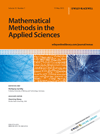The duality property of the Discrete Fourier Transform based on Simpson's rule
Abstract
The classical Discrete Fourier Transform (DFT) satisfies a duality property that transforms a discrete time signal to the frequency domain and back to the original domain. In doing so, the original signal is reversed to within a multiplicative factor, namely the dimension of the transformation matrix. In this paper, we prove that the DFT based on Simpson's method satisfies a similar property and illustrate its effect on a real discrete signal. The duality property is particularly useful in determining the components of the transformation matrix as well as components of its positive integral powers. Copyright © 2012 John Wiley & Sons, Ltd.




